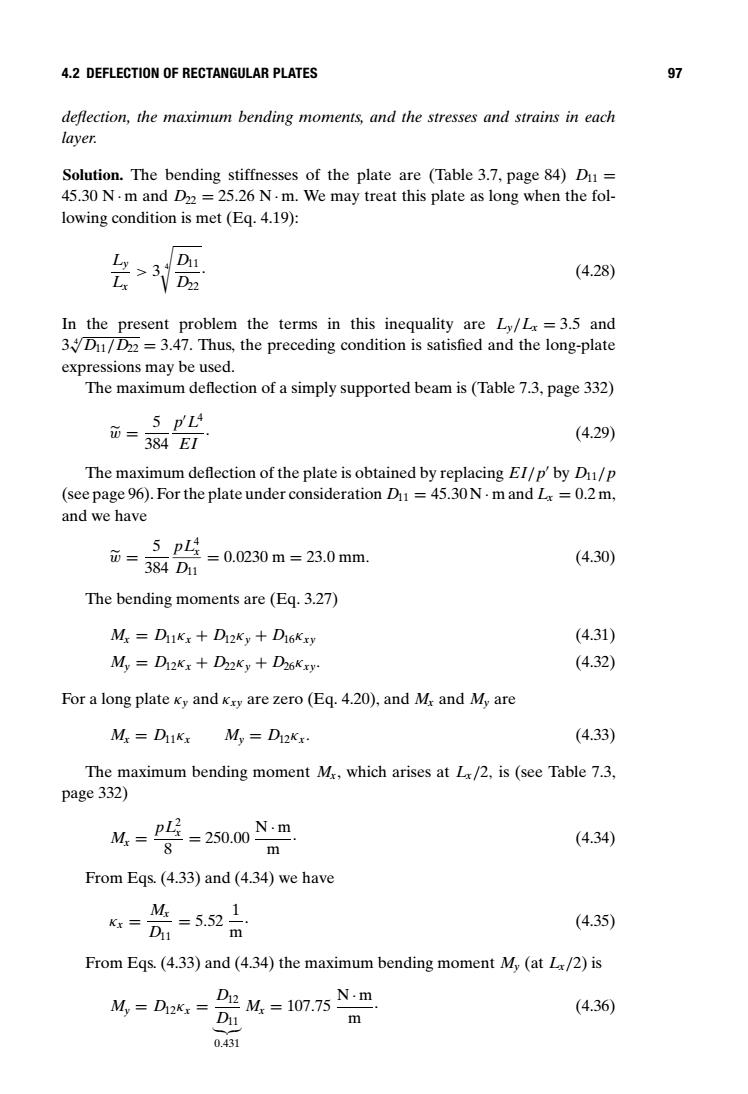正在加载图片...

4.2 DEFLECTION OF RECTANGULAR PLATES deflection,the maximum bending moments,and the stresses and strains in each layer. Solution.The bending stiffnesses of the plate are (Table 3.7,page 84)Du= 45.30 N.m and D22=25.26 N.m.We may treat this plate as long when the fol- lowing condition is met (Eq.4.19): Du (4.28) In the present problem the terms in this inequality are Ly/Lx=3.5 and 3D1/D22=3.47.Thus,the preceding condition is satisfied and the long-plate expressions may be used. The maximum deflection of a simply supported beam is(Table 7.3,page 332) 0三 5 PLA 384EI (4.29) The maximum deflection of the plate is obtained by replacing El/p'by Di/p (see page 96).For the plate under consideration Du=45.30N.m and L =0.2 m, and we have 5pL=0.0230m=23.0mm. ǔ=384D1 (4.30) The bending moments are(Eq.3.27) M D11Kx+D12Ky+D16Kty (4.31) My D12Kx D22Ky D26Kxy. (4.32) For a long plate Ky and Kry are zero(Eq.4.20),and Mr and My are M =D11Kx My D12Kx. (4.33) The maximum bending moment M,which arises at Lx/2,is(see Table 7.3, page 332) M=250.00N (4.34) 8 m From Eqs.(4.33)and(4.34)we have (4.35) m From Egs.(4.33)and (4.34)the maximum bending moment My (at L/2)is My=D12Kx D2M,=107.75 N.m (4.36) D11 m 0.4314.2 DEFLECTION OF RECTANGULAR PLATES 97 deflection, the maximum bending moments, and the stresses and strains in each layer. Solution. The bending stiffnesses of the plate are (Table 3.7, page 84) D11 = 45.30 N · m and D22 = 25.26 N · m. We may treat this plate as long when the following condition is met (Eq. 4.19): Ly Lx > 3 4 , D11 D22 . (4.28) In the present problem the terms in this inequality are Ly/Lx = 3.5 and 3 √4 D11/D22 = 3.47. Thus, the preceding condition is satisfied and the long-plate expressions may be used. The maximum deflection of a simply supported beam is (Table 7.3, page 332) w = 5 384 p L4 EI . (4.29) The maximum deflection of the plate is obtained by replacing EI/p by D11/p (see page 96). For the plate under consideration D11 = 45.30 N · m and Lx = 0.2 m, and we have w = 5 384 pL4 x D11 = 0.0230 m = 23.0 mm. (4.30) The bending moments are (Eq. 3.27) Mx = D11κx + D12κy + D16κxy (4.31) My = D12κx + D22κy + D26κxy. (4.32) For a long plate κy and κxy are zero (Eq. 4.20), and Mx and My are Mx = D11κx My = D12κx. (4.33) The maximum bending moment Mx, which arises at Lx/2, is (see Table 7.3, page 332) Mx = pL2 x 8 = 250.00 N · m m . (4.34) From Eqs. (4.33) and (4.34) we have κx = Mx D11 = 5.52 1 m. (4.35) From Eqs. (4.33) and (4.34) the maximum bending moment My (at Lx/2) is My = D12κx = D12 D11 %&'( 0.431 Mx = 107.75 N · m m . (4.36)����